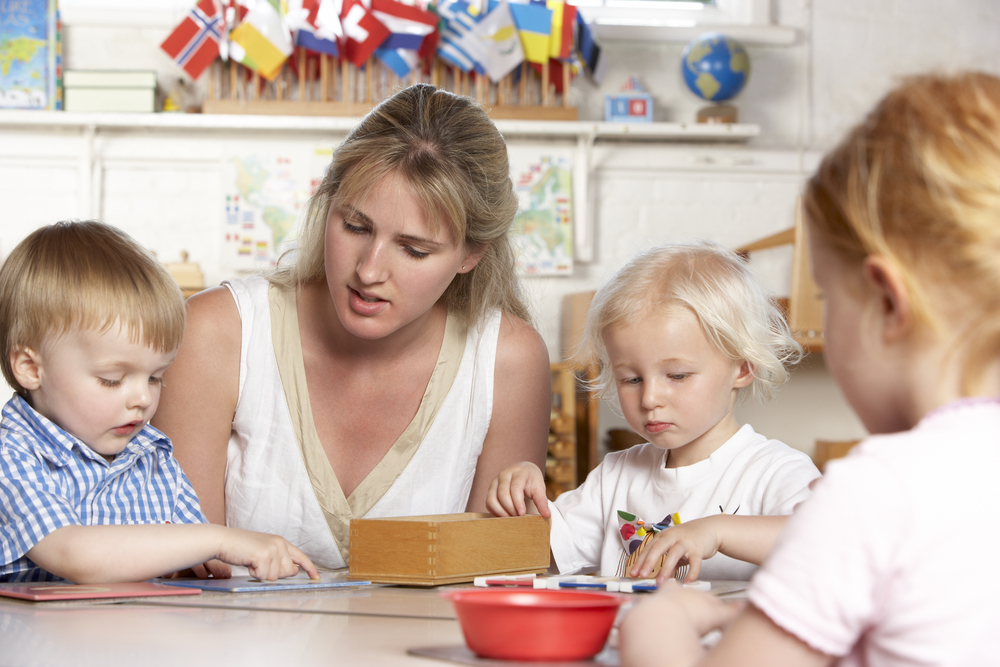Four Planes of Development in a Montessori School
When you walk into a Montessori school for the first time, one of the first things that you may notice is the classroom structure. Unlike a traditional school where the students are grouped together by birth year, where typically whole group learning is based on chronological age, a Montessori environment uses 3-year, mixed-age grouping, where instruction is personalized to meet individual and small group needs. This multi-age classroom structure is based on Dr. Montessori’s observations and work that revealed there are four different stages of development from birth to early adulthood. She referred to these as planes of development. Others in Psychology and Education may use the terms ‘stages’ or ‘phases’.
According to Dr. Montessori, each plane of development is characterized by distinct sensitive periods for learning – where children exhibit certain needs, attributes and characteristics at each plane of development. During these sensitive periods, a child undergoes a period of intense developmental change followed by a period of assimilation, marked by a student showing confidence in his newly acquired abilities. Using this model offers a holistic framework where learning and classroom structure is based on stages aligned with developmental psychology.
The Four Planes of Development are as follows:
The First Plane: Birth to Age 6 (Early Childhood)
During the first plane of development, children are soaking up the world. Dr. Montessori calls this the “absorbent mind,” meaning that the child’s brain has a sponge-like capacity to absorb from the environment all that is necessary to develop an individual from her specific culture.
At this age, children are focusing on the self and have a strong desire for physical independence. You will notice an “I can do it myself!” mentality. The foundation for a child’s personality is also laid during this time.
This plane is characterized by sensitive periods that include movement, language, toileting, order, grace and courtesy, music, reading, writing, social relationships, and mathematics.
The Second Plane: Ages 6–12 (Childhood)
The second plane of development is characterized by a thirst for knowledge and a strong desire for intellectual independence. You will notice an “I can think it myself!” mentality.
At this age, children begin searching for moral order and develop their conscience, or sense of right and wrong. This is a good time to teach your child fairness, and show him how he can help others.
During this stage, children learn from a “cosmic education” in a Montessori school, which encourages them to explore their place within the world, as well as appreciate the interconnectedness of all things.
The Third Plane: Ages 12–18 (Adolescence)
Marked by feelings of self-concern and self-assessment, the third plane of development is a sensitive period for critical thinking and exploring deeper moral and social values.
At this age, adolescents have a deep desire for emotional independence. You will notice an “I can stand on my own” mentality.
During this stage, the adolescent works on constructing his social self and feels the need to participate and have more control over his life.
The Fourth Plane: Ages 18–24 (Maturity)
The fourth plane of development is characterized by the young adult working on their spiritual self or constructing a higher-level of self-understanding.
This stage is marked by a strong desire for financial independence. You will notice an “I can get it myself” mentality.
During this time, the young adult discovers their place within the world and asks herself “What do I have to give to the world?”
The Planes of Development at Silverline Montessori School
At Silverline Montessori School, our education programs are designed to meet the needs of children in the first and second planes of development. Our focus is on developing the child’s potential during these distinct “windows of time” or sensitive periods. We keep our classroom sizes small to create an emotionally nurturing environment that is at the same time cognitively challenging. Our goal is to foster self-directed learners that become confident in their abilities by the end of each plane of development.
“The environment must be rich in motives which lend interest to activity and invite the child to conduct his own experiences.” – Dr. Maria Montessori


